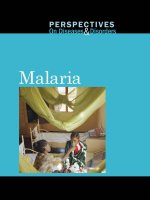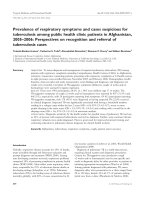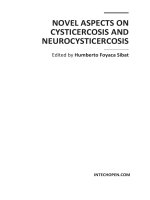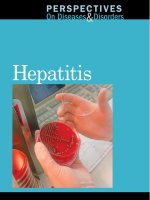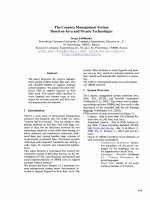The basal ganglia novel perspectives on motor and cognitive functions
Bạn đang xem bản rút gọn của tài liệu. Xem và tải ngay bản đầy đủ của tài liệu tại đây (14.7 MB, 587 trang )
Innovations in Cognitive Neuroscience
Series Editor: Vinoth Jagaroo
Jean-Jacques Soghomonian
Editor
The Basal Ganglia
Novel Perspectives on
Motor and Cognitive Functions
Innovations in Cognitive Neuroscience
More information about this series at />
Jean-Jacques Soghomonian
Editor
The Basal Ganglia
Novel Perspectives on Motor
and Cognitive Functions
Editor
Jean-Jacques Soghomonian
Department of Anatomy and Neurobiology
Boston University School of Medicine
Boston, MA, USA
ISSN 2509-730X
ISSN 2509-7318 (electronic)
Innovations in Cognitive Neuroscience
ISBN 978-3-319-42741-6
ISBN 978-3-319-42743-0 (eBook)
DOI 10.1007/978-3-319-42743-0
Library of Congress Control Number: 2016948218
© Springer International Publishing Switzerland 2016
This work is subject to copyright. All rights are reserved by the Publisher, whether the whole or part of
the material is concerned, specifically the rights of translation, reprinting, reuse of illustrations, recitation,
broadcasting, reproduction on microfilms or in any other physical way, and transmission or information
storage and retrieval, electronic adaptation, computer software, or by similar or dissimilar methodology
now known or hereafter developed.
The use of general descriptive names, registered names, trademarks, service marks, etc. in this publication
does not imply, even in the absence of a specific statement, that such names are exempt from the relevant
protective laws and regulations and therefore free for general use.
The publisher, the authors and the editors are safe to assume that the advice and information in this book
are believed to be true and accurate at the date of publication. Neither the publisher nor the authors or the
editors give a warranty, express or implied, with respect to the material contained herein or for any errors
or omissions that may have been made.
Printed on acid-free paper
This Springer imprint is published by Springer Nature
The registered company is Springer International Publishing AG Switzerland
To Allison and Emilie
Preface
Descriptions of the deep brain structures that have come to be called the “basal
ganglia” can be traced back as far as 350 years based on recorded anatomical observations, notably those published in 1664 by the English anatomist Thomas Willis.
Yet, for much of this time, the basal ganglia have held a certain enigmatic quality in
terms of their functions. The conception held late into the twentieth century that the
basal ganglia were associated largely with motor control or coordination had a few
roots. Basal ganglia ablation studies in animals that began in the nineteenth century
showed dramatically marked motor symptomatology. In clinical neurology, features
such as dystonia, dyskinesia, and chorea, manifesting in neurodegenerative disorders with known involvement of the basal ganglia structures, reasonably reinforced
the prominence of the motor-centered view.
Pioneering work in neurobiology conducted in the 1960s and 1970s began the
sea of change in the contemporary understanding of the basal ganglia. Progress was
made possible thanks to the advent of novel investigative methods that permitted
more precise analysis of anatomical pathways and the discovery of various neuronal
phenotypes throughout the basal ganglia. On another front, anatomical and physiological studies carried out in the late 1970s and early 1980s led to the concept of
parallel, segregated basal ganglia circuits, while other studies led to the concept of
a ventral, “limbic” basal ganglia, and, at a more cellular level, other studies led to
the concept of a direct and indirect pathway. These advances have been documented
in several reviews and volumes.
By the 1980s, there was early convergence of data from neuroscience and neuropsychology, broadening the conceptual framework of the basal ganglia to include
functions of cognition, emotion, and motivation. While the inertia in the motorcentered world of the basal ganglia did not fade overnight, studies from diverse
avenues of neuroscience, enabled by novel research techniques, began to reveal a
complex neural architecture and functional diversity. As a complex system of interface between intention and action, the role of the basal ganglia has encroached into
processes traditionally associated with the cerebral cortex and hippocampus such as
language, memory, reinforcement, and associative learning. Its role in the sequencing of learned associations was brought to bear on multiple functional domains.
vii
viii
Preface
This also highlighted its importance in neurocognitive, neuropsychiatric, and neurodegenerative motor disorders.
Over the last two decades, the intensification of neuroscience efforts combined
with astonishing advances in imaging, genetic, and molecular methods has led to
further demystify the basal ganglia and to revise its role in motor and non-motor
functions. It is now established that the basal ganglia can be subdivided into several
anatomical and functional territories that share different connectivity with cortical
and subcortical centers. These advances combined with a more detailed understanding of the cellular and molecular organization have provided the framework for
novel integrative and computational models of the basal ganglia.
Yet, even with all the progress in understanding the basal ganglia, perspective of
its functions as currently understood is neither readily present nor easily articulated
in the general arena of behavioral neuroscience. This volume presents many of the
recent developments relating to neural architecture and functional circuitry of the
basal ganglia; the role of the basal ganglia across many of the neurobehavioral
domains—motor and cognitive function, emotion, and motivation, etc.; and the
manifestations of these basal ganglia-mediated functions in various motor, cognitive, and neuropsychiatric disorders. The volume assembles contributions from eminent basal ganglia researchers and covers perspectives across subdisciplines of
neuroscience while being grounded in cognitive neuroscience and neurobiology. In
addition to the basal ganglia and neuroscience research community, the volume
should be of interest to practitioners in neuropsychology, neurology, neuropsychiatry, and speech-language pathology.
Boston, MA
Jean-Jacques Soghomonian
Acknowledgments
I am grateful to my colleagues for their generosity in contributing chapters to this
volume. I would also like to thank Janice Stern and Christina Tuballes at Springer
for their guidance and patience and the series editor Vinoth Jagaroo for his invitation to produce the volume, his constructive feedback, and his unwavering encouragement during the production of this volume. I acknowledge Yukiha Maruyama
and Kim Wang for their assistance with many aspects of the project especially with
preparation of the manuscript and Edith Soghomonian for her artistic renderings of
the basal ganglia.
ix
Contents
1
Introduction: Overview of the Basal Ganglia and Structure
of the Volume ...........................................................................................
Jean-Jacques Soghomonian and Vinoth Jagaroo
Part I
1
Functional and Anatomical Organization
of Basal Ganglia: Limbic and Motor Circuits
2
Limbic-Basal Ganglia Circuits Parallel and Integrative Aspects .......
Henk J. Groenewegen, Pieter Voorn, and Jørgen Scheel-Krüger
3
Anatomy and Function of the Direct and Indirect
Striatal Pathways ....................................................................................
Jean-Jacques Soghomonian
11
47
4
The Thalamostriatal System and Cognition .........................................
Yoland Smith, Rosa Villalba, and Adriana Galvan
69
5
Dopamine and Its Actions in the Basal Ganglia System......................
Daniel Bullock
87
Part II
Motor Function, Dystonia and Dyskinesia
6
Cortico-Striatal, Cognitive-Motor Interactions
Underlying Complex Movement Control Deficits................................ 117
Aaron Kucinski and Martin Sarter
7
Interactions Between the Basal Ganglia and the Cerebellum
and Role in Neurological Disorders....................................................... 135
Christopher H. Chen, Diany Paola Calderon, and Kamran Khodakhah
8
Signaling Mechanisms in L-DOPA-Induced Dyskinesia ...................... 155
Cristina Alcacer, Veronica Francardo, and M. Angela Cenci
xi
xii
Contents
Part III
Perception, Learning and Cognition
9
Cognitive and Perceptual Impairments in Parkinson’s Disease
Arising from Dysfunction of the Cortex and Basal Ganglia ............... 189
Deepti Putcha, Abhishek Jaywant, and Alice Cronin-Golomb
10
The Basal Ganglia and Language: A Tale of Two Loops ..................... 217
Anastasia Bohsali and Bruce Crosson
11
The Basal Ganglia Contribution to Controlled
and Automatic Processing ...................................................................... 243
Estrella Díaz, Juan-Pedro Vargas, and Juan-Carlos López
12
Striatal Mechanisms of Associative Learning
and Dysfunction in Neurological Disease .............................................. 261
Shaun R. Patel, Jennifer J. Cheng, Arjun R. Khanna,
Rupen Desai, and Emad N. Eskandar
13
Alcohol Effects on the Dorsal Striatum ................................................ 289
Mary H. Patton, Aparna P. Shah, and Brian N. Mathur
Part IV Motivation, Decision Making, Reinforcement and Addiction
14
The Subthalamic Nucleus and Reward-Related Processes ................. 319
Christelle Baunez
15
The Basal Ganglia and Decision-Making
in Neuropsychiatric Disorders ............................................................... 339
Sule Tinaz and Chantal E. Stern
16
Motivational Deficits in Parkinson’s Disease:
Role of the Dopaminergic System and Deep-Brain
Stimulation of the Subthalamic Nucleus ............................................... 363
Sabrina Boulet, Carole Carcenac, Marc Savasta,
and Sébastien Carnicella
17
The Circuitry Underlying the Reinstatement of Cocaine
Seeking: Modulation by Deep Brain Stimulation ................................ 389
Leonardo A. Guercio and R. Christopher Pierce
Part V Computational Models and Integrative Perspectives
18
Cognitive and Stimulus–Response Habit Functions
of the Neo- (Dorsal) Striatum................................................................. 413
Bryan D. Devan, Nufar Chaban, Jessica Piscopello,
Scott H. Deibel, and Robert J. McDonald
19
Neural Dynamics of the Basal Ganglia During Perceptual,
Cognitive, and Motor Learning and Gating ......................................... 457
Stephen Grossberg
Contents
20
xiii
The Basal Ganglia and Hierarchical Control
in Voluntary Behavior............................................................................. 513
Henry H. Yin
Index ................................................................................................................. 567
Contributors
Cristina Alcacer, Ph.D. Basal Ganglia Pathophysiology Unit, Department of
Experimental Medical Sciences, Lund University, Lund, Sweden
Christelle Baunez, Ph.D. Institut de Neurosciences de la Timone, UMR7289
CNRS & Aix-Marseille Université, Marseille, France
Anastasia Bohsali, Ph.D. VA Rehabilitation Research and Development Brain
Rehabilitation Research Center of Excellence, Gainesville, FL, USA
Department of Neurology, University of Florida, Gainesville, FL, USA
Sabrina Boulet, Ph.D. Inserm, U836, Grenoble, France
University of Grenoble Alpes, Grenoble, France
Daniel Bullock, Ph.D. Department of Psychological and Brain Sciences, Boston
University, Boston, MA, USA
Diany Paola Calderon, M.D., Ph.D. Laboratory for Neurobiology and Behavior,
The Rockefeller University, New York, NY, USA
Carole Carcenac, Ph.D. Inserm, U836, Grenoble, France
University of Grenoble Alpes, Grenoble, France
Sébastien Carnicella, Ph.D. Inserm, U836, Grenoble, France
University of Grenoble Alpes, Grenoble, France
M. Angela Cenci, M.D., Ph.D. Basal Ganglia Pathophysiology Unit, Department
of Experimental Medical Sciences, Lund University, Lund, Sweden
Nufar Chaban Laboratory of Comparative Neuropsychology, Psychology
Department, Towson University, Towson, MD, USA
Christopher H. Chen Dominick P. Purpura Department of Neuroscience, Albert
Einstein College of Medicine, Bronx, NY, USA
xv
xvi
Contributors
Jennifer J. Cheng Department Neurosurgery, Massachusetts General Hospital,
Harvard Medical School, Boston, MA, USA
Alice Cronin-Golomb, Ph.D. Department of Psychological and Brain Sciences,
Boston University, Boston, MA, USA
Bruce Crosson, Ph.D. VA Rehabilitation Research and Development Center of
Excellence for Visual and Neurocognitive Rehabilitation, Decatur, GA, USA
Departments of Neurology and Radiology, Emory University, Atlanta, GA, USA
Department of Psychology, Georgia State University, Atlanta, GA, USA
School of Health and Rehabilitation Sciences, University of Queensland, St Lucia,
QLD, Australia
Scott H. Deibel Department of Neuroscience, Canadian Center for Behavioural
Neuroscience, University of Lethbridge, Lethbridge, AB, Canada
Rupen Desai Department of Neurosurgery, Duke University Medical Center,
Durham, NC, USA
Bryan D. Devan, Ph.D. Laboratory of Comparative Neuropsychology, Psychology
Department, Towson University, Towson, MD, USA
Estrella Díaz, Ph.D. Animal Behavior and Neuroscience Lab, Dpt. Psicologia
Experimental, School of Psychology, Universidad de Sevilla, Sevilla, Spain
Emad N. Eskandar, M.D. Department Neurosurgery, Massachusetts General
Hospital, Harvard Medical School, Boston, MA, USA
Veronica Francardo, M.D. Basal Ganglia Pathophysiology Unit, Department of
Experimental Medical Sciences, Lund University, Lund, Sweden
Adriana Galvan, Ph.D. Department of Neurology, Yerkes Primate Research
Center, Emory University, Atlanta, GA, USA
Henk J. Groenewegen, M.D., Ph.D. Department of Anatomy and Neurosciences,
VU University Medical Center, Amsterdam, The Netherlands
Stephen Grossberg, Ph.D. Department of Mathematics, Center for Adaptive
Systems and Graduate Program in Cognitive and Neural Systems, Center for
Computational Neuroscience and Neural Technology, Boston University, Boston,
MA, USA
Leonardo A. Guercio Neuroscience Graduate Group, Perelman School of
Medicine, University of Pennsylvania, Philadelphia, PA, USA
Department of Psychiatry, Center for Neurobiology and Behavior, Perelman School
of Medicine, University of Pennsylvania, Philadelphia, PA, USA
Contributors
xvii
Vinoth Jagaroo, Ph.D. Department of Communication Sciences and Disorders,
Emerson College, Boston, MA, USA
Behavioral Neuroscience Program, Boston University School of Medicine, Boston,
MA, USA
Abhishek Jaywant, M.A. Department of Psychological and Brain Sciences,
Boston University, Boston, MA, USA
Arjun R. Khanna Department of Neurobiology, Harvard Medical School, Boston,
MA, USA
Kamran Khodakhah, Ph.D. Dominick P. Purpura Department of Neuroscience,
Albert Einstein College of Medicine, Bronx, NY, USA
Aaron Kucinski, Ph.D. Department of Psychology and Neuroscience Program,
University of Michigan, Ann Arbor, MI, USA
Juan-Carlos López, Ph.D. Animal Behavior and Neuroscience Laboratory, Dpt.
Psicologia Experimental, School of Psychology, Universidad de Sevilla, Sevilla,
Spain
Brian N. Mathur, Ph.D. Department of Pharmacology, University of Maryland
School of Medicine, Baltimore, MD, USA
Robert J. McDonald, Ph.D. Department of Neuroscience, Canadian Center for
Behavioural Neuroscience, University of Lethbridge, Lethbridge, AB, Canada
Shaun R. Patel, Ph.D. Department Neurosurgery, Massachusetts General Hospital,
Harvard Medical School, Boston, MA, USA
Mary H. Patton Department of Pharmacology, University of Maryland School of
Medicine, Baltimore, MD, USA
R. Christopher Pierce, Ph.D. Department of Psychiatry, Center for Neurobiology
and Behavior, Perelman School of Medicine, University of Pennsylvania,
Philadelphia, PA, USA
Jessica Piscopello Laboratory of Comparative Neuropsychology, Psychology
Department, Towson University, Towson, MD, USA
Deepti Putcha, Ph.D. Department of Psychological and Brain Sciences, Boston
University, Boston, MA, USA
Martin Sarter, Ph.D. Department of Psychology and Neuroscience Program,
University of Michigan, Ann Arbor, MI, USA
Marc Savasta, Ph.D. Inserm, U836, Grenoble, France
University of Grenoble Alpes, Grenoble, France
Jørgen Scheel-Krüger, Ph.D. Center of Functionally Integrative Neuroscience
(CFIN), University of Aarhus, Aarhus, Denmark
xviii
Contributors
Aparna P. Shah, Ph.D. Department of Pharmacology, University of Maryland
School of Medicine, Baltimore, MD, USA
Yoland Smith, Ph.D. Department of Neurology, Yerkes Primate Research Center,
Emory University, Atlanta, GA, USA
Jean-Jacques Soghomonian, Ph.D. Department of Anatomy and Neurobiology,
Boston University School of Medicine, Boston, MA, USA
Chantal E. Stern, D.Phil. Department of Psychological and Brain Sciences,
Center for Memory and Brain, Boston University, Boston, MA, USA
Sule Tinaz, M.D., Ph.D. Department of Neurology, Yale School of Medicine, New
Haven, CT, USA
Juan-Pedro Vargas, Ph.D. Animal Behavior and Neuroscience Laboratory,
Department of Experimental Psychology, School of Psychology, Universidad de
Sevilla, Sevilla, Spain
Rosa Villalba, Ph.D. Department of Neurology, Yerkes Primate Research Center,
Emory University, Atlanta, GA, USA
Pieter Voorn, Ph.D. Department of Anatomy and Neurosciences, VU University
Medical Center, Amsterdam, The Netherlands
Henry H. Yin, Ph.D. Department of Psychology and Neuroscience, Duke
University, Durham, NC, USA
Department of Neurobiology and Center for Cognitive Neuroscience, Duke
University, Durham, NC, USA
Abbreviations
AC
ac
AC5/6
ACA
AcbC
AcbSh
ACC
ACd
ACh
AChE
ACv
ADHD
AHC
AI
AID
AIMs
Alv
AMPA
AMPAR
Amyg
AP-1
A-PE
arc
ATP1A3
aVITE model
BAC
BBB
BDNF
Adenylyl cyclase
Anterior commissure
Adenylyl cyclase 5/6
Anterior cingulate area
Core of the nucleus accumbens
Shell of the nucleus accumbens
Anterior cingulate cortex
Dorsal anterior cingulate cortex
Acetylcholine
Acetylcholinesterase
Ventral anterior cingulate cortex
Attention deficit hyperactivity disorder
Alternating hemiplegia of childhood
Anterior insular
Dorsal agranular insular cortex
Abnormal involuntary movements
Ventral agranular insular cortex
α-Amino-3-hydroxy-5-methyl-4-isoxazole propionic acid
Glutamate AMPA receptor
Amygdala
Activator protein 1
Aversive prediction error
Activity-regulated cytoskeleton-associated protein
ATP1A3 gene
Adaptive VITE model
Basal amygdaloid complex
Blood-brain barrier
Brain-derived neurotrophic factor
xix
xx
BEC
BF
BG
BLA
BOLD
BP
BST
CA1
CA1 region
CalDAG-GEFI
CalDAG-GEFII
cAMP
cARTWORD model
Caudate (DL)
Caudate (VM)
CB1
CBM
cBmg
cBpc
cc
Cd
cdm-GPi
CeA
CEN
ChAT
CHI
ChIN or ChINs
CIE
cl-SNr
CM
CogEM model
CP or CPu
CPvm
CQ
CR
CRE
CS or CS+
CSF
CS-US
D1
Abbreviations
Blood ethanol concentration
Basal forebrain
Basal ganglia
Basolateral amygdala
Blood oxygen level-dependent
Bipolar disorder
Bed nucleus of the stria terminalis
Hippocampal CA1 cells
Cornu ammonis area 1
Calcium- and DAG-regulated guanine exchange factor-1
Calcium- and DAG-regulated guanine exchange factor-2
Cyclic adenosine monophosphate
Conscious ARTWORD
Dorsolateral caudate
Ventromedial caudate
Cannabinoid-type receptor 1
Assumed cerebello-cortical input to the IFV stage
Caudal part of the magnocellular basal amygdaloid nucleus
Caudal part of the parvicellular basal amygdaloid nucleus
Corpus callosum
Caudate
Caudodorsomedial globus pallidus (internal segment)
Central nucleus of the amygdala
Central executive network
Choline acetyltransferase
Striatal aspiny cholinergic interneurons
Cholinergic interneurons
Chronic intermittent ethanol exposure
Caudolateral substantia nigra pars reticulata
Central medial thalamic nucleus
Cognitive-emotional-motor model
Caudate-putamen
Ventromedial part of caudate-putamen
Competitive queuing
Conditioned response
CREB responsive elements
Conditioned stimulus
Cerebrospinal fluid
Conditional stimulus-unconditional stimulus
Dopamine D1 receptor
Abbreviations
D1-M4-SP-DYN-GABA-MSPN
D1-MSPN
D1 or D1R
D2-M1-ENK-GABA-MSPN
D2-MSPN or D2-MSPS
D2 or D2R
D3 or D3R
DA
DA2D
DA-ACh
DAergic projection
DAergic R-PE
DARPP-32
dARTSCAN model
DAT
DAT KO
DBS
DCN
DID
DIRECT model
DIVA model
DL
DLL
DLO
DLPFC
DLR
DLS
DMN
DMS
DOPAergic
dopamine D1
dopamine D2
Drd1a or drd1a
Drd2-EGFP
DREAM
DRN
DSM-IV
xxi
Direct pathway striatal neurons
Direct pathway striatal neurons
Dopamine D1 receptor
Indirect pathway striatal neurons
Indirect pathway striatal neurons expressing
the dopamine D2 receptor
Dopamine D2 receptor
Dopamine D3 receptor
Dopamine
Dopamine receptor 2D
Dopamine-acetylcholine
Dopaminergic projection
Dopamine-mediated reward-prediction error
Dopamine- and cAMP-regulated neuronal
phosphoprotein
Distributed ARTSCAN
Dopamine transporter
Dopamine transporter knockout
Deep brain stimulation
Deep cerebellar nuclei
Mouse protocol called “drinking in the dark”
Direction-to-rotation effector control transform
model
Directions-into-velocities of articulators model
Dopamine lesions
Long-lasting disinhibition
Dorsolateral orbital cortex
Dorsolateral prefrontal cortex
Diencephalic locomotor region
Dorsolateral striatum
Default mode network
Dorsomedial striatum
Dopaminergic
Dopamine D1 receptor
Dopamine D2 receptor
Dopamine D1a receptor
Dopamine D2 receptor promotor combined
with enhanced green fluorescent protein
Downstream regulatory element antagonistic
modulator
Dorsal raphe nucleus
Diagnostic and Statistical Manual of Mental
Disorders IV
xxii
dSPNs
DVV
DV
DYT1
DYT11
DYT12
DYT4
EA
EC
EC50
eCBs
EEG
Egr-1
EP or EPN or ENP
EPm
EPSC
EPSP
ERK
ERK1/2
fcMRI
FDA
FEF
FLETE model
fMRI
FOG
fr
FR1
FR2
Fra-1
FS or FSI or FSIN
GABA
GABA-SI
Glu or GLU
GluA2-flip
GluN1
GluN2A
GluN2B
GO
GPCR
GPe
Abbreviations
Direct pathway spiny projection neurons
Desired velocity vector
Difference vector
Early-onset primary dystonia
Myoclonus dystonia
Rapid-onset dystonia parkinsonism
Whispering dysphonia
Extended amygdala
Entorhinal cortex
Half-maximal effective concentration
Endogenous cannabinoids/endocannabinoids
Electroencephalogram
Early growth response 1
Entopeduncular nucleus
Medial part of the entopeduncular nucleus
Excitatory postsynaptic current
Excitatory postsynaptic potential
Extracellular signal-regulated kinase
Extracellular signal-regulated kinases 1 and 2
Functional connectivity magnetic resonance imaging
Food and Drug Administration
Frontal eye fields
Factorization of length and tension model
Functional magnetic resonance imaging
Freezing of gate
Fasciculus retroflexus
FR1 schedule of reinforcement
Frontal area 2
fos-like antigen
Fast-spiking interneurons
Gamma aminobutyric acid
GABAergic striatal interneurons
Glutamate
Glutamate AMPA receptor GluA2 subunit
Glutamate NMDA receptor subunit 1
Glutamate NMDA receptor subunit 2A
Glutamate NMDA receptor subunit 2B
Scaleable basal ganglia gating signal
G protein-coupled receptors
External (lateral) segment of the globus pallidus
Abbreviations
GPi
G-protein
Gq
GRK
GRK6
GTPγS
Gu2A-flip
Gαolf
H-ABC
cerebellum
HDB
HFS
Hipp or HPC
HPLC
HTT
IC50
ICeA
IEG
IGT
IL
IN
IP3
IPSCs
iSPNs
ISR
IT
ITa
ITA
ITp
IVTA
Kir2
L
L-DOPA or levodopa
LFP
LH
LH_gus
LH_in
LHb
LI
LID
LIP
LIST PARSE model
lisTELOS model
xxiii
Internal (medial) segment of the globus pallidus
G protein-coupled
Gq protein-coupled receptors
G protein-coupled receptor kinases
G protein-coupled receptor kinase 6
GTPγS binding
Specific splicing variant of the GluA2 subunit
(“GluA2-flip”)
G protein-coupled receptor olfactory
Hypomyelination with atrophy of basal ganglia and
Horizontal nucleus of the diagonal band
High-frequency stimulation
Hippocampus
High-performance liquid chromatography
Huntingtin gene
Half-maximal inhibitory concentration
Lateral part of the central amygdala nucleus
Immediate-early genes
Iowa gambling task
Infralimbic cortex
Inertial force vector
Inositol phosphate 3
Inhibitory postsynaptic currents
Indirect pathway spiny projection neurons
Immediate serial recall
Inferotemporal cortex
Anterior inferotemporal cortex
Inferotemporal cortex
Posterior inferotemporal cortex
Lateral part of the ventral tegmental area
Potassium channel, inward rectifying
Lateral thalamic nucleus
L-3,4-Dihydroxyphenylalanine
Local field potential
Lateral hypothalamus
Gustatory-responsive lateral hypothalamic cells
Lateral hypothalamic input cells
Lateral habenula
Latent inhibition
L-DOPA-induced dyskinesia
Lateral intraparietal cortex
Laminar integrated storage of temporal patterns for associative retrieval, sequencing, and execution
List telencephalic laminar objective selector
xxiv
LO
LPD
LPO
LTD
LTF
LTM
LTP
LTSI
l-VAmc
Abbreviations
Lateral orbital cortex
Left-side onset Parkinson’s disease
Lateral preoptica area
Long-term depression
Long-term facilitation
Long-term memory
Long-term potentiation
Low-threshold-spiking interneurons
Lateral ventral anterior nucleus of thalamus pars
magnocellularis
LVF
Left visual field
M1/M1R
M1-type muscarinic acetylcholine receptor
M4R
M4-type muscarinic acetylcholine receptor
mAChR
Muscarinic acetylcholine receptor
mAHPs
Medium after-hyperpolarization potentials
MAPK
Mitogen-activated kinase
MCMCT
Michigan complex motor control task
MD
Mediodorsal thalamic nucleus
MDD
Major depressive disorder
MDmc
Magnocellular subnucleus of mediodorsal nucleus of the
thalamus
mdm-GPi
Dorsomedial globus pallidus (internal segment)
MDpl
Parvocellular subnucleus of mediodorsal nucleus of the
thalamus
MdSNs
Medium densely spiny neurons
MEA
Midbrain extrapyramidal area
MEK1/2
Mitogen-activated protein kinase kinase 1/2
mEPSC
Miniature excitatory postsynaptic current
mGluR
Metabotropic glutamate receptor
MGP
Medial globus pallidus (Gpi)
MHb
Medial habenula
mIPSCs
Miniature inhibitory postsynaptic currents
MLR
Mesencephalic locomotor region
MO
Medial orbital cortex
MOR
Mu opioid receptor
MORB
Medial orbitofrontal
MOTIVATOR model Matching objects to internal values triggers option revaluations model
MOVO
Medial orbital and ventral orbital cortices
mPFC
Medial prefrontal cortex
MPTP
1-methyl-4-phenyl-1,2,3,6-tetrahydropyridine
MRaphe
Median raphe nucleus
MRI
Magnetic resonance imaging
mRNA
Messenger RNA
mSN
Medial part of the substantia nigra
Abbreviations
MSN or MSNs or MSPNs
mTOR
mTORC1
m-VAmc
NA
NAc or NAcc or Nac
NAcc-C
NAcc-Sh
nAChR
Narp
nbM
NMDA
NMDAR
NO
non-NE
NOS
nptx2
NR2A
NR2B
oBST
OCD
OFC
OFPV
OPV
ORB
OT
P or SP
PAG
PC
PD
PE
pERK
PET
PF of Th
PFC
PIVC
PKA
PKC
PL
PLC
PLd
PLT
PLv
pm-MD
xxv
Striatal medium spiny neurons
Mammalian target of rapamycin
mammalian target of rapamycin complex 1
Medial ventral anterior nucleus of thalamus pars
magnocellularis
Noradrenaline
Nucleus accumbens
Accumbens nucleus core
Accumbens nucleus shell
Nicotinic acetylcholine receptor
Neuronal activity-regulated pentraxin
Nucleus basalis of Meynert
N-methyl-d-aspartate
Glutamate NMDA receptor
Nitric oxide
Non-noradrenergic
NO synthase
nptx2 gene
Glutamate NMDA receptor 2A subunit
Glutamate NMDA receptor 2B subunit
Oval portion of the bed nucleus of the stria terminalis
Obsessive-compulsive disorder
Orbitofrontal cortex
Outflow force-plus-position vector
Outflow position vector
Orbital frontal
Olfactory tubercle
Neuropeptide substance P
Periaqueductal gray matter
Paracentral thalamic nucleus
Parkinson’s disease
Prediction error
Phosphorylated extracellular signal-regulated protein
kinase
Positron emission tomography
Parafascicular nucleus of the thalamus
Prefrontal cortex
Parieto-insular vestibular cortex
Protein kinase A
Protein kinase C
Prelimbic cortex
Phospholipase C
Dorsal prelimbic cortex
Persistent low-threshold
Ventral prelimbic cortex
Posteromedial mediodorsal nucleus of the thalamus
xxvi
PNR-THAL
PP-1
PPC
PPN or PPTN
PPV
PS
PSE
pThr34-DARPP32
Pu
PV
rBmg
rCBF
RDP
Rhes
RHIN
rl-GPi
RLi
RMP
rm-SNr
RMTg
R-O
Rp-cAMPS
RPD
RPE or R-PE
RPM
RRA
RT-PCR
RVF
S6
sAHPs
SC
SCZ
SD
SEF
sEPSCs
Ser
SFV
Shp-2
shRNA
SI
siRNA
SMA
SN
SNc
SNr
Abbreviations
Pallidal or nigral input-receiving regions of the thalamus
Protein phosphatase 1
Posterior parietal cortex
Pedunculopontine nucleus
Perceived position vector
Population spike
Point of subjective equality
Thr-34-phosphorylated DARPP32
Putamen
Paraventricular thalamic nucleus
Rostral part of the magnocellular basal amygdaloid nucleus
Regional cerebral blood flow
Rapid-onset dystonia parkinsonism
ras homolog enriched in striatum
Rhinal cortex
Rostrolateral globus pallidus internal
Rostral linear nucleus of the raphe
Resting membrane potential
Rostromedial substantia nigra pars reticulata
Rostromedial tegmental nucleus
Response-outcome
Phosphodiesterase-resistant analogue of cAMP
Right-side onset Parkinson’s disease
Reward prediction error
Rotations per minute
Retrorubral area
Real-time polymerase chain reaction
Right visual field
Ribosomal protein S6 (pS235/236)
Slow after-hyperpolarization potentials
Superior colliculus
Schizophrenia
Striosomes
Supplementary eye fields
Spontaneous excitatory synaptic currents
Serine
Static force vector
Tyrosine phosphatase Shp-2
Short hairpin RNA
Substantia innominata
Silencing RNA
Supplementary motor area
Substantia nigra
Pars compacta of the substantia nigra
Pars reticulata of the substantia nigra
Abbreviations
SOPT
SP
SPECT
SPNs
S-R
SSI
SSM
STEP
STm
STN
STN-DBS
STN-HFS
Sub
TANs or TAN
tDCS
TELOS
TH-IR
Thr
TMS
TPV
TRAP
TS
TTX
TUBB4A
US
V4
VA
VEGF
VGluT1
VGluT2
VI-30s
vIPAG
VITE model
VL
Vl-GPi
Vlm
VLo
VLO
vl-SNr
vmPFC
VO
VP
vPAG
VPd
VPm
xxvii
Speed of processing training
Substance P
Single photon emission computed tomography
Spiny projection neurons
Stimulus-response
Somatostatin-containing interneurons
Speech sound map
Striatal-enriched protein tyrosine phosphatase
Medial part of the subthalamic nucleus
Subthalamic nucleus
Deep brain stimulation of the subthalamic nucleus
High-frequency stimulation of the subthalamic nucleus
Subiculum
Tonically active neurons
Transcranial direct current stimulation
Telencephalic laminar objective selector
Tyrosine hydroxylase immunoreactivity
Threonine
Transcranial magnetic stimulation
Target position vector
Translating ribosome affinity purification
Tourette syndrome
Tetrodotoxin
TUBB4A gene
Unconditioned stimulus
Prestriate cortical area
Ventral anterior nucleus of the thalamus
Vascular endothelial growth factor
Vesicular glutamate transporter 1
Vesicular glutamate transporter 2
Variable interval schedule of reinforcement-30 seconds
Ventrolateral periaqueductal gray
Vector integration to endpoint
Ventrolateral thalamic nucleus
Ventrolateral globus pallidus (internal segment)
Ventrolateral nucleus of thalamus pars medialis
Ventrolateral nucleus of thalamus pars oralis
Ventrolateral orbital cortex
Ventrolateral substantia nigra pars reticulata
Ventromedial prefrontal cortex
Ventral orbital cortex
Ventral pallidum
Ventral periaqueductal gray
Dorsal part of the ventral pallidum
Medial part of the ventral pallidum
xxviii
vPMC
VPv
VPvl
VPvm
VS
VTA
WM
∆JunD
32 kDa
6-OHDA
A2a receptor
ATP1 α3
Abbreviations
Ventral premotor cortex
Ventral part of the ventral pallidum
Ventrolateral part of the ventral pallidum
Ventromedial part of the ventral pallidum
Ventral striatum
Ventral tegmental area
Working memory
Transcription factor ΔJunD
Dopamine- and cAMP-regulated phosphoprotein, 32 kDa
6-Hydroxydopamine
Adenosine A2a receptor
Sodium/potassium-transporting ATPase subunit alpha-3


